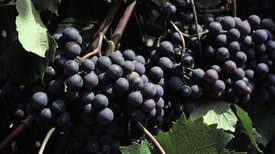撰文\播音:克里斯托弗·因塔利亚塔(Christopher Intagliata)
翻译:邱燕宁
审校:潘磊
The fires that ripped across Napa and Sonoma last year damaged some two dozen wineries, and burned others completely to the ground.
去年在Napa和Sonoma肆虐的大火,摧毁了20多家酒厂,把一切烧个精光。
"Yeah and also don't forget Chile burned pretty good this year, too. In fact fires there destroyed quite a few old vineyards." Wes Zandberg, an analytical chemist at the University of British Columbia, at the Okanagan campus, right in B.C.'s wine country. "Basically this is a problem in North and South America this year."
“别忘了今年智利的火势也很凶。实际上,大火毁了多个古老的葡萄园。”Wes Zandberg是不列颠哥伦比亚大学(UBC)的分析化学家,他所在的Okanagan分校就位于当地一个盛产葡萄酒的村子。“事实上,这火灾是今年北美和南美地区共同的大问题。”
Even wineries that are unscathed by fire may suffer from smoke passing through their vineyards. Because it can leave that year's vintage with unpleasant smoky notes.
即使是未被大火波及的酒庄,飘过葡萄园的烟霾也会为之带来不少烦恼。因为今年酿的酒很可能会带上令人不悦的烟火味。
Zandberg and his team studied that process with an experimental plot of cabernet franc vines—five of which they exposed to woo smoke, and five they left alone.
Zandberg和他的团队在一片品丽珠葡萄的试验区研究这个过程——其中五株葡萄藤被不断冒出的烟雾笼罩,另五株则隔离种植。
They found that when volatile compounds in smoke land on grapes, the fruit very quickly sucks the chemical into its skin or flesh. Then it tags sugar molecules onto the smoky compounds, which renders the smoky substances water soluble, and nontoxic. But that chemical conversion leaves the compounds with no scent or taste…, which means winemakers can't detect them in grapes… until it's too late.
他们发现,当烟雾中的挥发性化合物附着在葡萄果实上,它会很快地把化学物质吸收到果皮或果肉中。然后将多糖分子标记在烟熏化合物上,使烟雾物质变得水溶、无毒。而这样的化学转化也使得烟雾的化合物消逝气味和味道…,也就意味着,酿酒工人检测不到葡萄中的烟雾物质…到真正发现时已经晚了。
"The problem is when you take a bunch of grape juice and expose it to yeast during the fermentation process, the yeast have the required enzymes to cleave that sugar from the smoke-flavored compounds, so it kind of unmasks them during fermentation." Making them once again detectable by nose and tongue.
“问题在于,使用酵母发酵葡萄汁时,酵母中的酶可以从复合物中分离出多糖。这个过程类似于把烟雾物质伪装的面具揭下来。”它们再次能被鼻子和舌头觉察。
The findings are in the Journal of Agricultural and Food Chemistry. [Matthew Noestheden, Eric G. Dennis, and Wesley F. Zandberg, Quantitating Volatile Phenols in Cabernet Franc Berries and Wine after On-Vine Exposure to Smoke from a Simulated Forest Fire]
这项研究结果发表在《农业与食品化学杂志》上。
The study was funded in part by a local chemical testing company, which hopes to develop a test for various smoky substances in the grapes, to predict whether so-called 'smoke taint' will be a perceptible problem in the finished wine.
研究部分资金来自一家当地的化学测试公司,这个公司希望能开发一种能测试葡萄中的各种烟雾物质的方法,以预测所谓的“烟雾污染”,是否会成为成酒中的一个显著问题。
Until then, Zandberg has this advice for wildfire-affected winemakers: "One obvious strategy for minimizing smoke taint in wine, is don't put it in a toasted oak barrel. That's just going to put more compounds in there that give that odor, or flavor."
目前,Zandberg对受野火影响的葡萄酒生产商提出了这样的建议:“在葡萄酒中减少烟雾污染的一个直观策略就是,不要把酒盛放在烤橡木桶里。”如果不这么做,将会带入更多化合物到酒里,从而使葡萄酒产生那样烟的气味或味道。

 京公网安备11010502039775号
京公网安备11010502039775号  京公网安备11010502039775号
京公网安备11010502039775号 
















